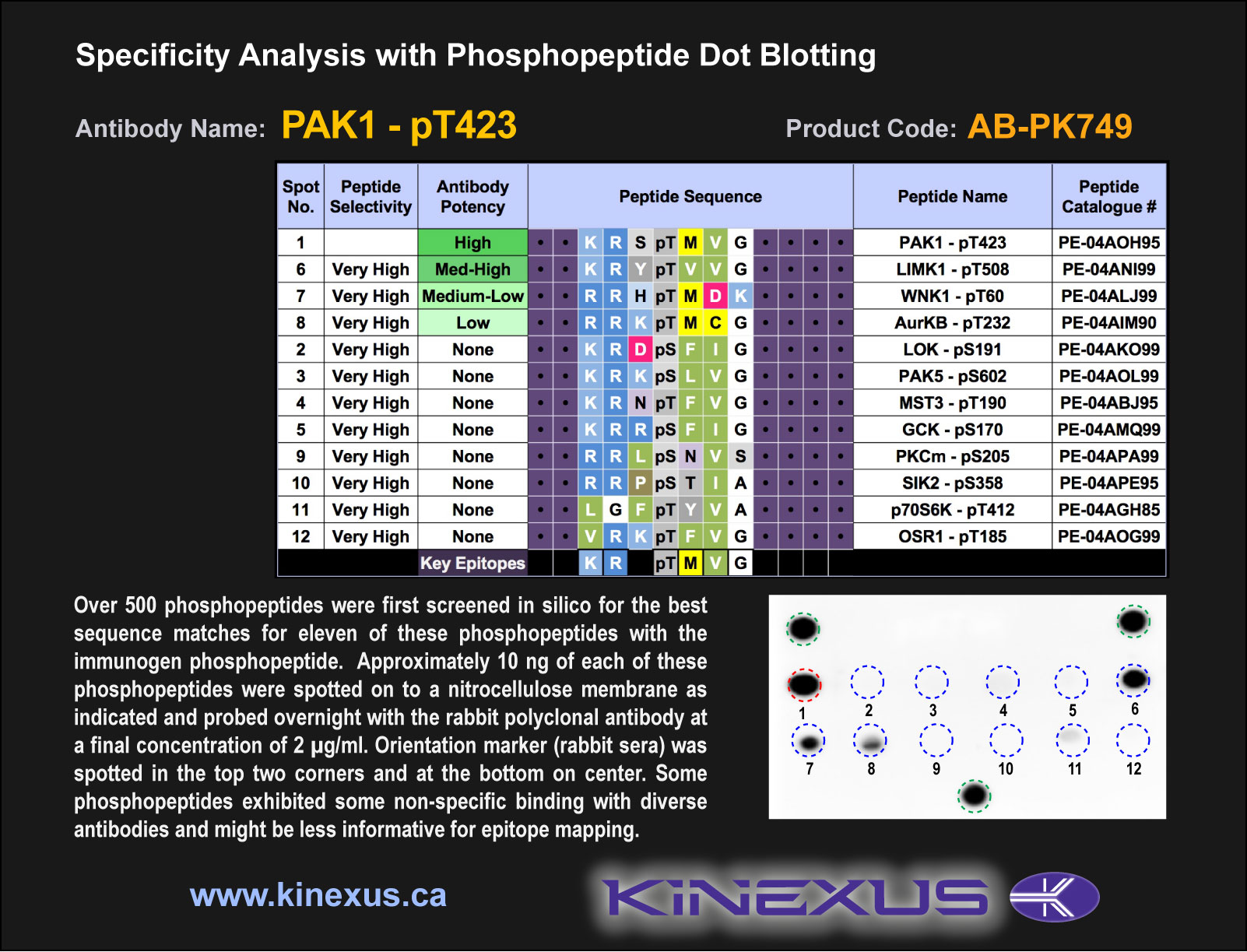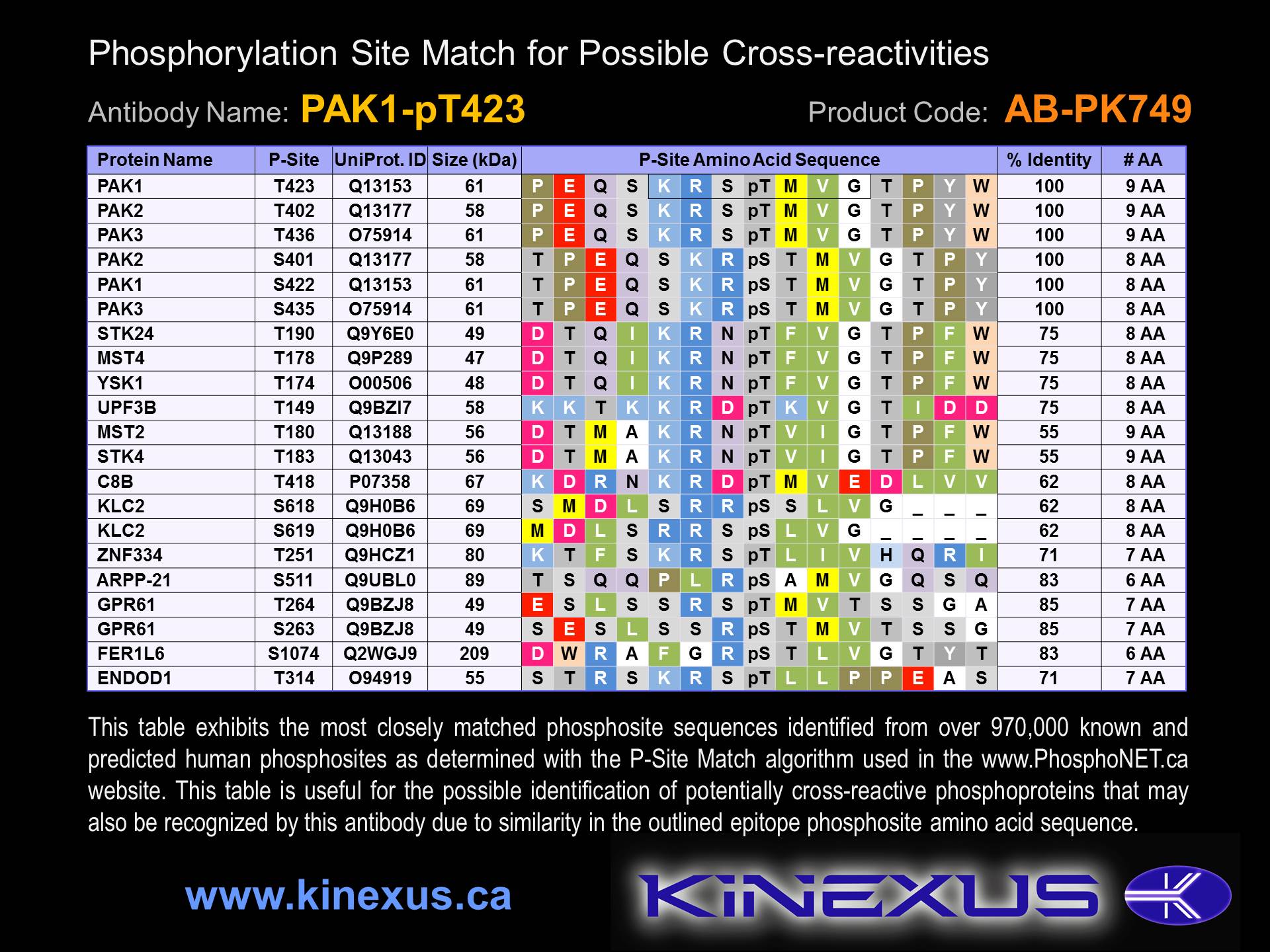Product Name: PAK1-pT423
Product Number: AB-PK749
| Size: | 25 µg | Price: | 89.00 | |
| $US |
Target Full Name: p21-activated kinase 1 alpha; Protein-serine/threonine kinase PAK 1
Target Alias: ADRB2; Alpha-PAK; CDC42,RAC effector kinase PAK-A; CDC42/RAC effector kinase PAK-A; Kinase PAK1; MUK2; P21 protein (Cdc42/Rac)-activated kinase 1; P65-PAK; STE20, yeast; P68-PAK; PAK 1; PAK-1; PAKA; Protein kinase MUK2; PAKalpha; MGC130000; MGC130001; CCDS8250.1; Q13153; ENSG00000149269
Product Type Specific: Protein kinase phosphosite-specific antibody
Antibody Code: PK749
Antibody Target Type: Phosphosite-specific
Antibody Phosphosite: T423
Protein UniProt: Q13153
Protein SigNET: Q13153
Target Alias: ADRB2; Alpha-PAK; CDC42,RAC effector kinase PAK-A; CDC42/RAC effector kinase PAK-A; Kinase PAK1; MUK2; P21 protein (Cdc42/Rac)-activated kinase 1; P65-PAK; STE20, yeast; P68-PAK; PAK 1; PAK-1; PAKA; Protein kinase MUK2; PAKalpha; MGC130000; MGC130001; CCDS8250.1; Q13153; ENSG00000149269
Product Type Specific: Protein kinase phosphosite-specific antibody
Antibody Code: PK749
Antibody Target Type: Phosphosite-specific
Antibody Phosphosite: T423
Protein UniProt: Q13153
Protein SigNET: Q13153
Antibody Type: Polyclonal
Antibody Host Species: Rabbit
Antibody Immunogen Source: Human PAK1 (PAKa) sequence peptide Cat. No.: PE-04AOH95
Antibody Immunogen Sequence: KRS(pT)MVG(bA)C
Antibody Immunogen Description: Corresponds to amino acid residues K420 to G426; In protein kinase catalytic domain activation T-loop between subdomains VII and VIII.
Antibody Host Species: Rabbit
Antibody Immunogen Source: Human PAK1 (PAKa) sequence peptide Cat. No.: PE-04AOH95
Antibody Immunogen Sequence: KRS(pT)MVG(bA)C
Antibody Immunogen Description: Corresponds to amino acid residues K420 to G426; In protein kinase catalytic domain activation T-loop between subdomains VII and VIII.
Production Method: The immunizing peptide was produced by solid phase synthesis on a multipep peptide synthesizer and purified by reverse-phase hplc chromatography. Purity was assessed by analytical hplc and the amino acid sequence confirmed by mass spectrometry analysis. This peptide was coupled to KLH prior to immunization into rabbits. New Zealand White rabbits were subcutaneously injected with KLH-coupled immunizing peptide every 4 weeks for 4 months. The sera from these animals was applied onto an agarose column to which the immunogen peptide was thio-linked. Antibody was eluted from the column with 0.1 M glycine, pH 2.5. Subsequently, the antibody solution was neutralized to pH 7.0 with saturated Tris.This antibody was also subject to negative purification over phosphotyrosine-agarose.
Antibody Modification: Unconjugated. Contact KInexus if you are interest in having the antibody biotinylated or coupled with fluorescent dyes.
Antibody Modification: Unconjugated. Contact KInexus if you are interest in having the antibody biotinylated or coupled with fluorescent dyes.
Antibody Concentration: 1 mg/ml
Storage Buffer: Phosphate buffered saline pH 7.4, 0.05% Thimerasol
Storage Conditions: For long term storage, keep frozen at -40°C or lower. Stock solution can be kept at +4°C for more than 3 months. Avoid repeated freeze-thaw cycles.
Product Use: Western blotting | Antibody microarray
Antibody Dilution Recommended: 2 µg/ml for immunoblotting
Antibody Potency: Very strong immunoreactivity with immunogen peptide on dot blots.
Antibody Species Reactivity: Human
Antibody Positive Control: The observed molecular mass of the processed target protein on SDS-PAGE gels is reported to be around 60-67 kDa.
Storage Buffer: Phosphate buffered saline pH 7.4, 0.05% Thimerasol
Storage Conditions: For long term storage, keep frozen at -40°C or lower. Stock solution can be kept at +4°C for more than 3 months. Avoid repeated freeze-thaw cycles.
Product Use: Western blotting | Antibody microarray
Antibody Dilution Recommended: 2 µg/ml for immunoblotting
Antibody Potency: Very strong immunoreactivity with immunogen peptide on dot blots.
Antibody Species Reactivity: Human
Antibody Positive Control: The observed molecular mass of the processed target protein on SDS-PAGE gels is reported to be around 60-67 kDa.
Related Product 1: PAK1-pT423 blocking peptide
Related Product 2: PAK1-NT (PAK1-1) pan-specific antibody (Cat. No.: AB-NK122-2)
Related Product 3: PAK1-pS144 phosphosite-specific antibody (Cat. No.: AB-PK748)
Related Product 4: PAktide KinSub - PAK peptide substrate
Related Product 5: PAK1Subtide - PAK1 protein kinase substrate peptide
Related Product 2: PAK1-NT (PAK1-1) pan-specific antibody (Cat. No.: AB-NK122-2)
Related Product 3: PAK1-pS144 phosphosite-specific antibody (Cat. No.: AB-PK748)
Related Product 4: PAktide KinSub - PAK peptide substrate
Related Product 5: PAK1Subtide - PAK1 protein kinase substrate peptide
Scientific Background: PAK1 is a protein-serine/threonine kinase that is a member of the STE group of protein kinases in the STE20 family, and PAKA subfamily. This kinase is highly expressed and widely distributed in most tested human tissues. PAK1 has been implicated in the regulation of cytoskeletal organization, and cell proliferation and survival, morphology, motility and transformation. Binding of GTP-bound Cdc42 or Rac1 to the autoregulatory region at the N-terminus of PAK1 releases monomers from the autoinhibited dimer, enables phosphorylation at T423 and activation of its phosphotransferase activity. It is also activated by binding to GTP-bound Cdc42, independent of the phosphorylation state of T423. Phosphorylation of S144, S149, and T423 increases PAK1's phosphotransferase activity, whereas phosphorylation of T84 (by OXSR1) and Y212 inhibits its phosphotransferase activity. Phosphorylation of S21 inhibits binding of Nck and PIX. PAK1 may be a therapeutic target in B-Raf wild-type melanoma. Knockdown of PAK1 has been shown to inhibit the proliferation of mutant KRAS colon cancer cells.
Figure 1. Epitope mapping of PAK1-pT423 antibody with similar phosphopeptides on dot blots.
Figure 2. Identification of phosphosites related to PAK1-pT423.
© Kinexus Bioinformatics Corporation 2017



